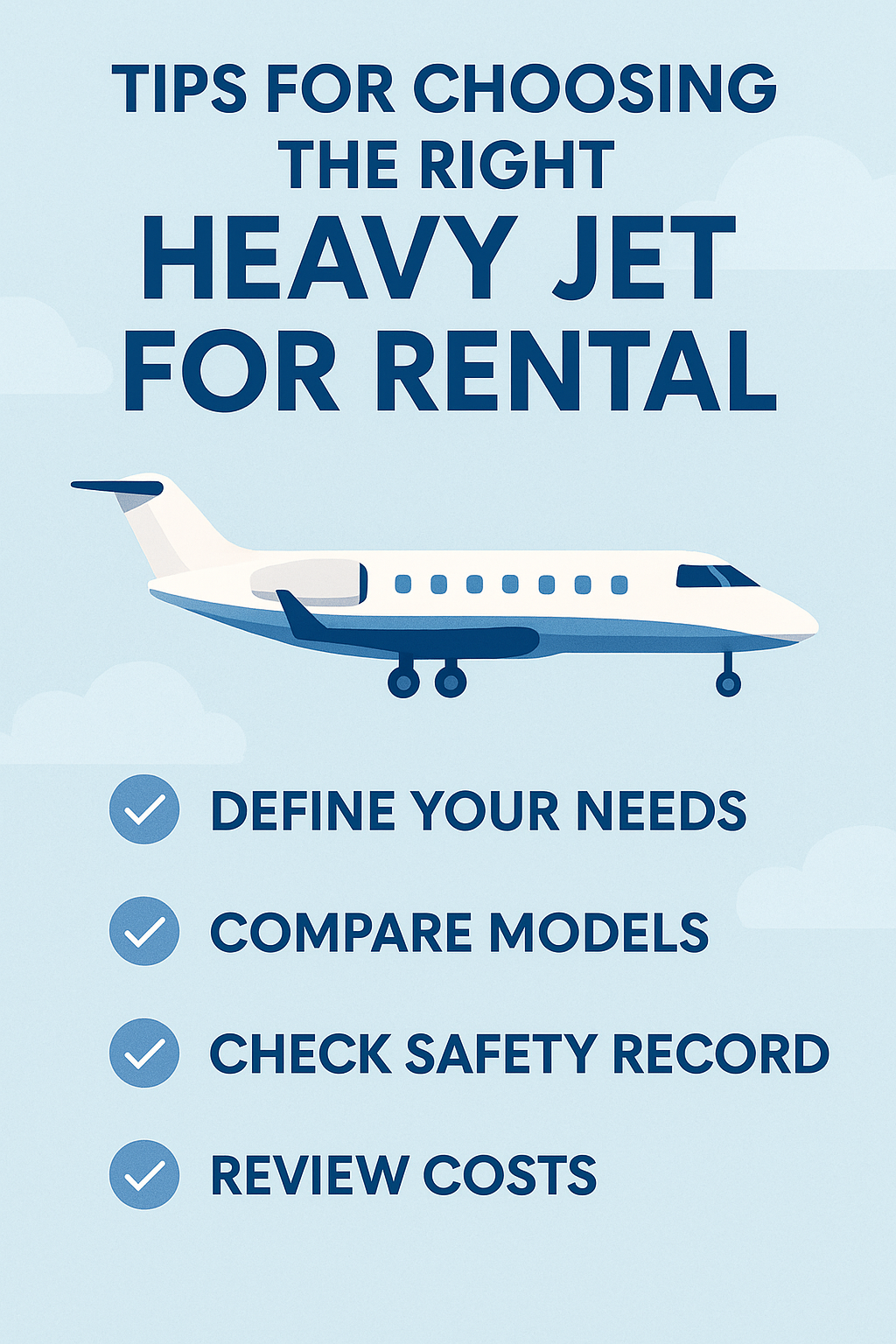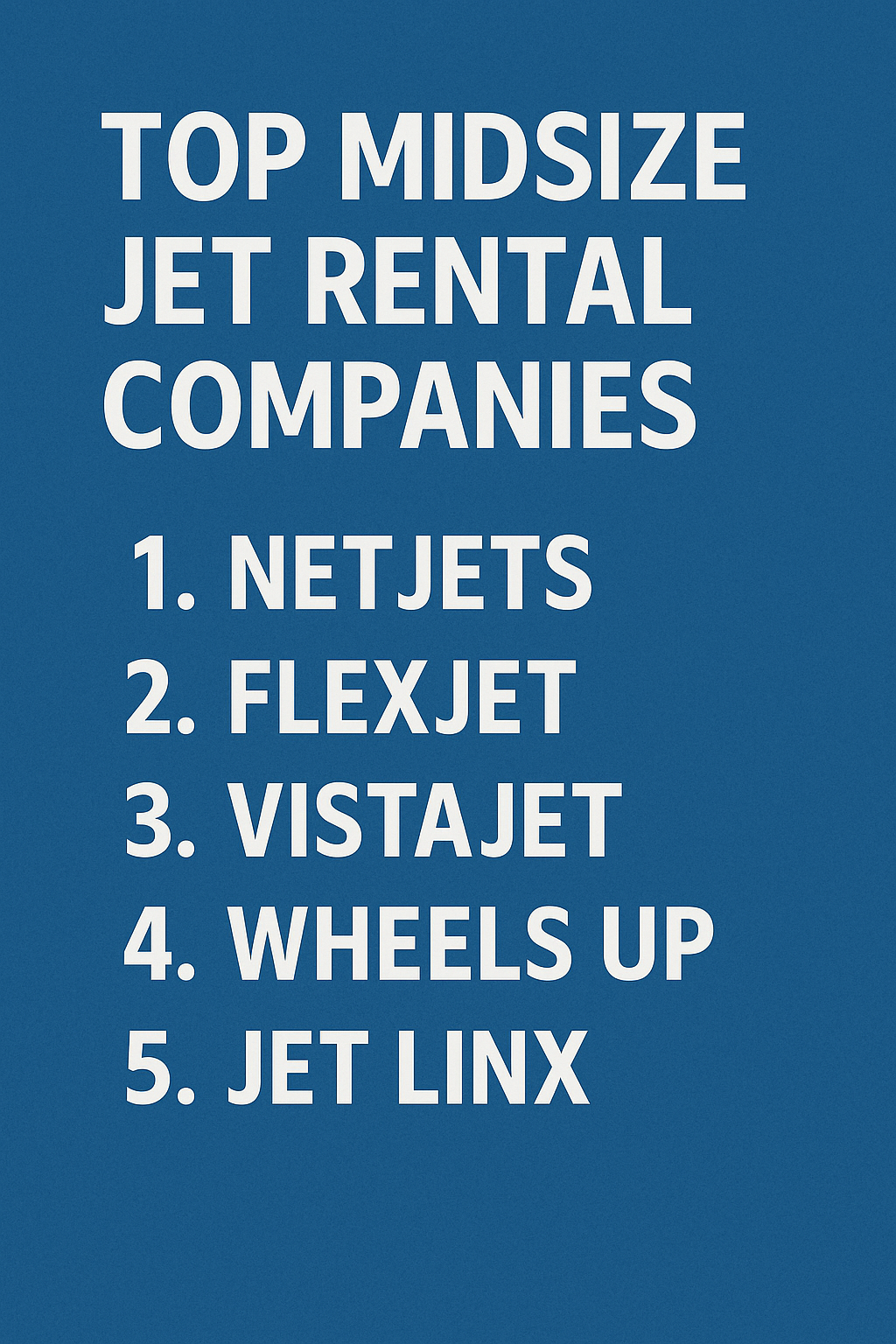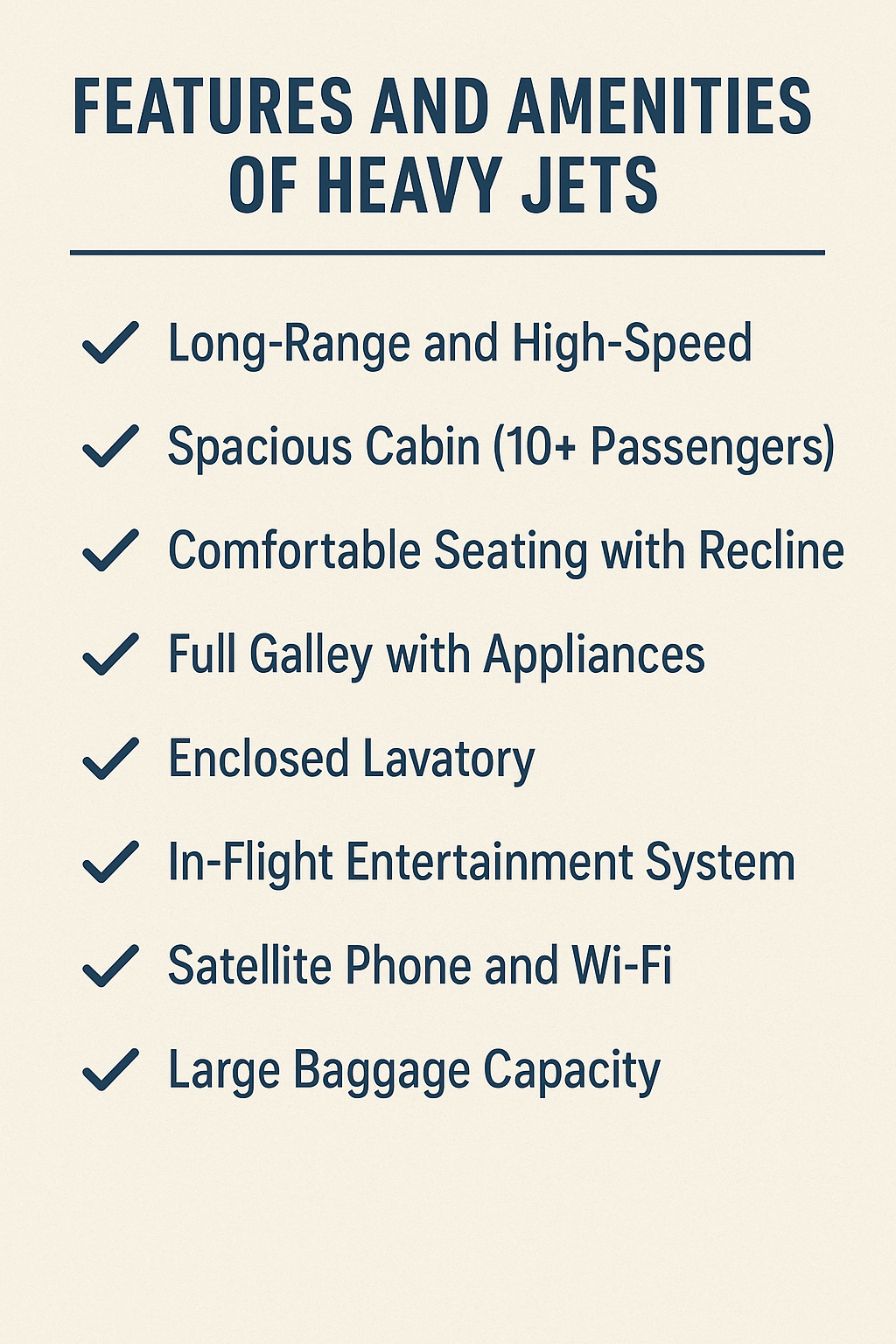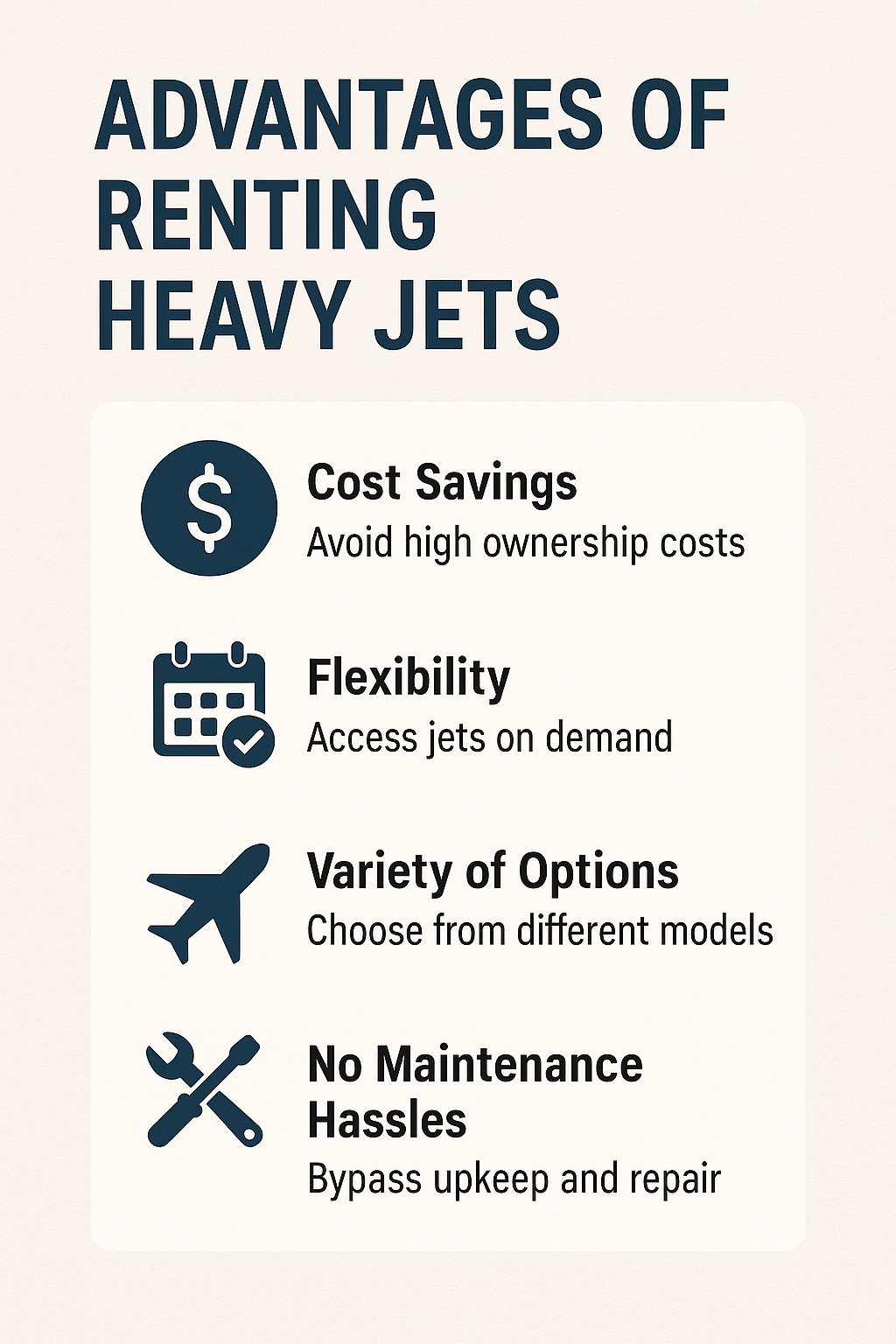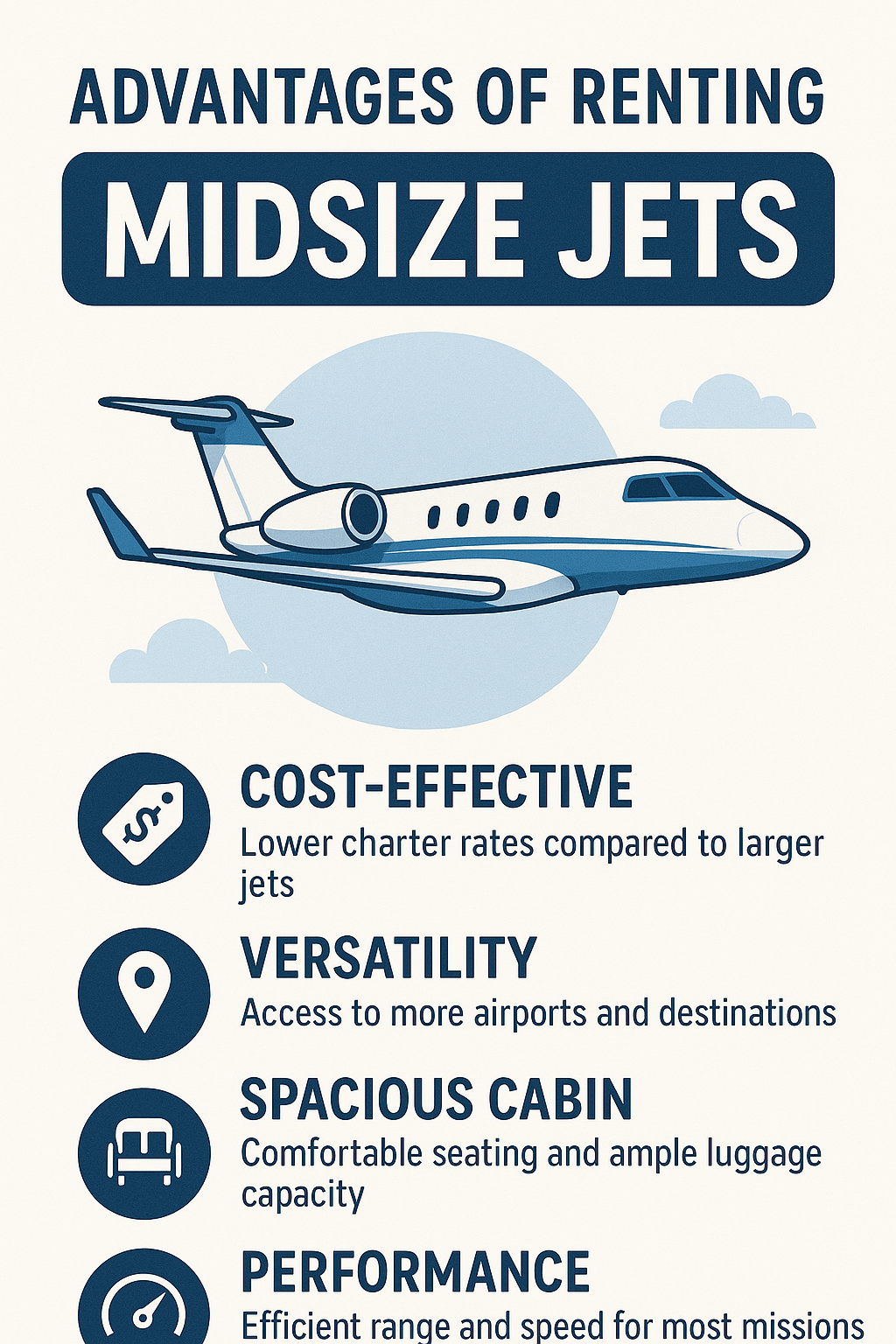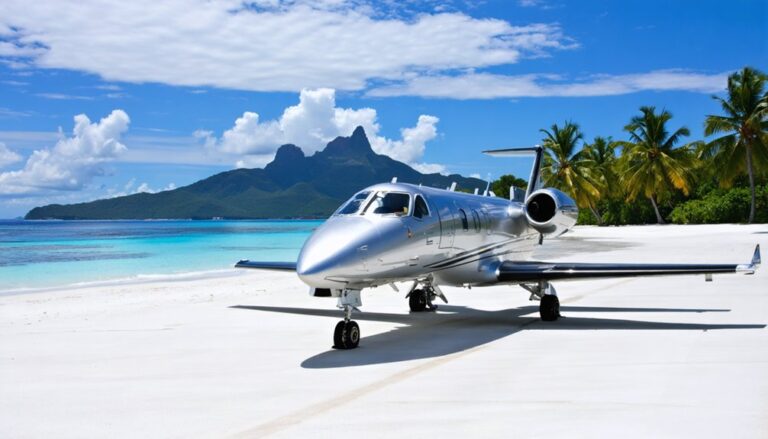Tips for Choosing the Right Heavy Jet for Rental
Choosing the right heavy jet for rental involves looking at several important factors. First, think about passenger capacity. Heavy jets usually accommodate between 10 to 16 passengers, making them suitable for larger groups.
Next, consider your flight range. Many heavy jets can fly over 5,000 miles without needing to refuel. This means you can travel long distances comfortably.
Cabin comfort is also crucial. Look for jets that offer spacious interiors with luxurious features. You want a relaxing environment during your flight.
Luggage capacity matters too. Heavy jets can often carry up to 2,000 pounds of baggage. This is great for trips where you need to bring a lot of gear.
Airport compatibility is another key point. Some jets can access smaller airports, which might be closer to your destination.
Ensure the operator you choose has Part 135 certification. This certification shows they meet safety and operational standards.
Compare the hourly rates, which typically range from $5,000 to $10,000. Don’t forget to check for additional fees that might apply.
If you can, consider booking during off-peak times. This could lead to savings of around 75%.
These guidelines can help you find the perfect heavy jet for your travel needs.
Key Takeaways
When choosing a heavy jet for rental, think about how many passengers you’ll have. The right cabin layout can make a big difference in comfort during your flight. Some jets can hold more people but might not have the same spacious feel.
Next, look at where you want to go. Different jets have different ranges. If you often fly long distances, make sure the jet you choose can handle those trips without needing extra stops.
Safety is crucial. Check the jet’s safety record and confirm it has Part 135 certification. This ensures the jet meets strict safety standards. Also, see if it has medical amenities in case of emergencies.
Don’t forget to consider the overall costs. Look beyond the base rental price. Additional fees can add up quickly. You might find good deals during off-peak times, so keep an eye out for those.
Finally, make sure the jet can land at the airports you plan to use. Some airports have specific runway requirements. If you’re flying internationally, check if customs services are available at your destination. This can save you time and hassle when you arrive.
Assessing Your Passenger Capacity Needs
When you think about renting a heavy jet, consider how many people will be traveling with you. Knowing your group size is crucial for choosing the right aircraft. Heavy jets typically fit 10 to 16 passengers, making them perfect for larger groups flying internationally.
Take a moment to assess your maximum passenger count before making a reservation. Many heavy jets have layouts that seat 8 to 12 people, providing enough room for work and relaxation.
For example, the Challenger 850 is a great option, as it can comfortably accommodate up to 15 passengers.
Also, keep in mind the need for extra seating. If your group is bringing a lot of luggage or needs space for meetings during the flight, this can be important.
Getting the right passenger capacity ensures everyone has a comfortable and enjoyable experience, which is what heavy jets are all about.
Determining Flight Range Requirements
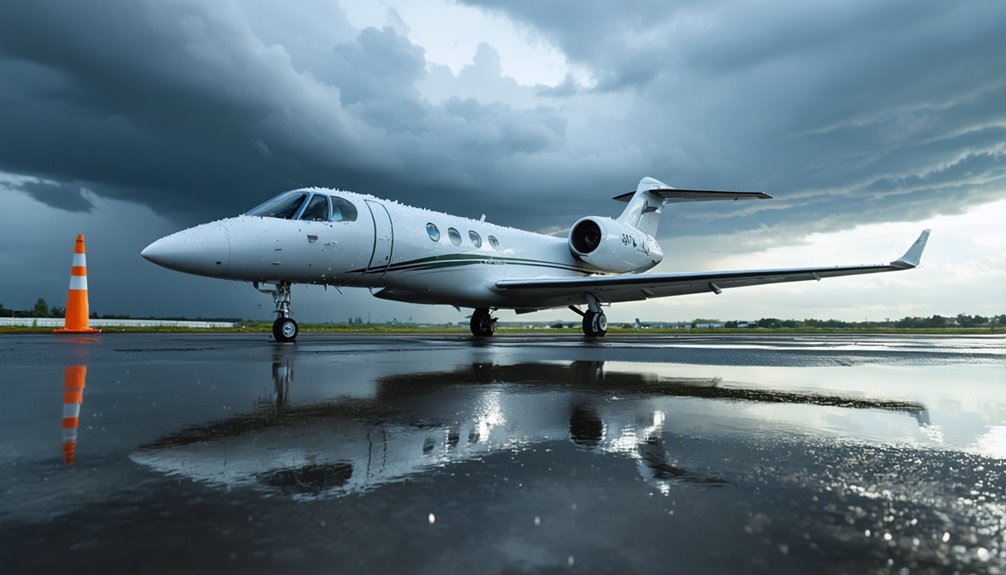
When considering heavy jets for rental, you must evaluate your flight range needs. Heavy jets have excellent range capabilities, often exceeding 5,000 miles without needing to refuel. This is crucial for international trips where time and efficiency matter.
Think about your usual routes and destinations. The distance in nautical miles will guide you in selecting the right aircraft for your journey.
| Destination Type | Typical Range Needed | Recommended Heavy Jet |
|---|---|---|
| Domestic | 2,000-3,000 nm | Challenger 650 |
| Continental | 3,000-4,000 nm | Falcon 2000LXS |
| Transatlantic | 4,000-5,000 nm | Gulfstream GIV-SP |
| Global | 5,000+ nm | Global 6000 |
Each type of heavy jet serves different travel needs. Domestic trips can often be handled by models like the Challenger 650. For continental travel, the Falcon 2000LXS is a solid choice. If you’re crossing the Atlantic, consider the Gulfstream GIV-SP. For global travel, the Global 6000 stands out as a top option.
Choosing the correct heavy jet ensures a smooth and efficient travel experience. Understanding your range requirements helps in making the best decision for your flight plans.
Understanding Cabin Size and Comfort Features
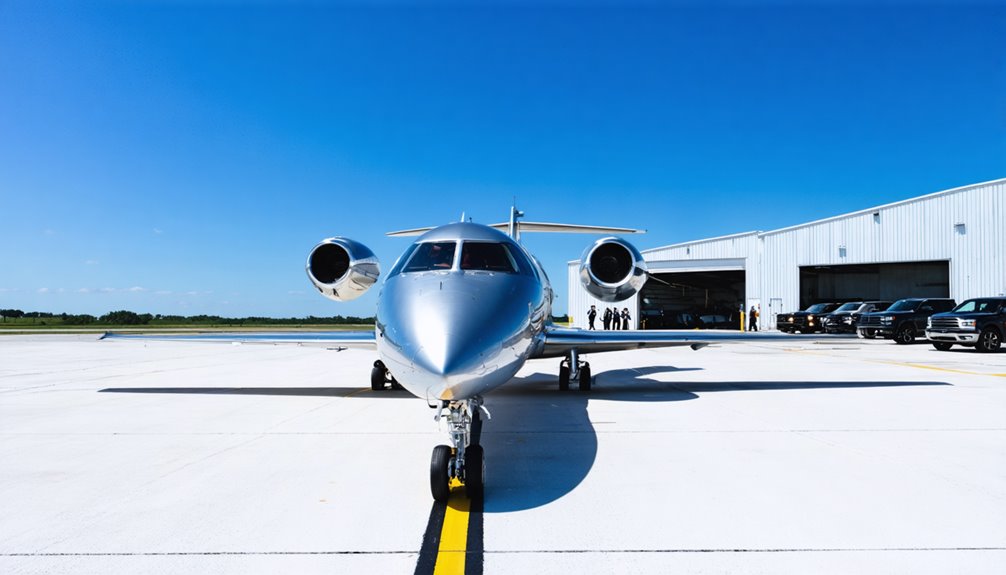
When it comes to heavy jets, their size and comfort features play a big role in your travel experience. Typically, these jets can carry between 10 to 16 passengers, but many are set up for 8 to 12. This setup helps create a spacious cabin that enhances comfort on long flights.
When you look at heavy jets, focus on their comfort options. Good models have smartly designed interiors. You’ll find club seating, foldable meeting tables, and power outlets. These features make it easy to relax or get work done.
Some jets even have separate areas for working, dining, and unwinding, which adds to the overall experience.
For long trips, it’s wise to choose jets with great amenities. Look for well-equipped galleys, dual lavatories, and even shower facilities. These thoughtful extras can turn your flight into a comfortable and productive journey.
Evaluating Luggage Storage Capacity
When you rent a heavy jet, luggage space is often overlooked, but it’s essential for an enjoyable trip. Heavy jets are known for their impressive luggage capacity. They can easily carry everything from golf clubs to ski gear. Many can handle over 1,000 pounds of baggage, making them ideal for groups or long journeys.
Before you book your private jet charter, check the specific luggage configurations. Some heavy jets have special compartments for larger items. This means your valuable belongings stay safe during the flight.
Comparing Costs and Budget Considerations
Heavy jets are a popular choice for those needing spacious, comfortable travel for long distances. The cost to rent these aircraft can vary widely, influenced by several important factors. You might save a lot by comparing costs before you book. Hidden fees can sneak in and drive up your total expenses.
| Cost Category | Budget Considerations |
|---|---|
| Base Hourly Rate | Ranges from $5,000 to $10,000, depending on the model |
| Additional Fees | Expect 10-20% for maintenance and management |
| Flight Duration | Transcontinental flights often exceed $30,000 |
| Peak vs. Off-Peak | Off-peak times can save you up to 75% |
| Extras | Fuel, landing fees, and catering are extra |
It’s wise to set aside funds for these hidden costs early in your planning. Look into empty-leg flights. These can offer significant discounts. Always ask for detailed quotes that break down each potential charge. This way, you can avoid any unexpected costs. Heavy jets like the Gulfstream G650 or Bombardier Global Express provide luxury and speed. Make sure you understand all aspects of the rental process to ensure a smooth journey.
Examining Aircraft Performance Specifications
When looking at heavy jets for rental, the first thing to consider is the range. Most heavy jets can fly around 4,117 nautical miles, which is great for crossing oceans without needing to refuel.
If your travel plans require longer distances, check out the Gulfstream GIV-SP. It can cover an impressive 4,728 nautical miles, perfect for those direct international flights.
Next, payload capacity matters a lot. This tells you how many people you can take on board. Typically, heavy jets hold between 10 to 16 passengers.
Also, think about your luggage and equipment. You need to balance this with the jet’s fuel efficiency. The right jet ensures a comfortable trip while maximizing your cargo space.
Range Maximum Assessment
When choosing a heavy jet for long-distance travel, understanding its maximum range is crucial. This aspect plays a vital role in ensuring that your journey can be completed without the need for refueling. Not having to stop saves time and adds to the convenience of your trip.
Here’s a look at some popular heavy jets and their range capabilities:
| Aircraft Model | Range (NM) | Key Benefit |
|---|---|---|
| Standard Heavy Jet | 4,117 | Capable of trans-oceanic flights |
| Gulfstream GIV-SP | 4,728 | Ideal for direct US-to-Europe travel |
| Long-range Models | 5,000+ | Offers intercontinental travel freedom |
Assessing the range of a heavy jet goes beyond mere statistics. It’s about aligning the aircraft’s capabilities with your travel requirements. Many travelers misjudge the distances involved in international private jet trips. A heavy jet with limited range can lead to unplanned fuel stops, which can extend your travel time significantly.
Choosing the right jet ensures a smooth journey. Heavy jets are designed for long distances, and understanding their range helps you make informed decisions. A well-chosen aircraft enhances your travel experience, allowing you to reach your destination efficiently.
Payload Capacity Comparison
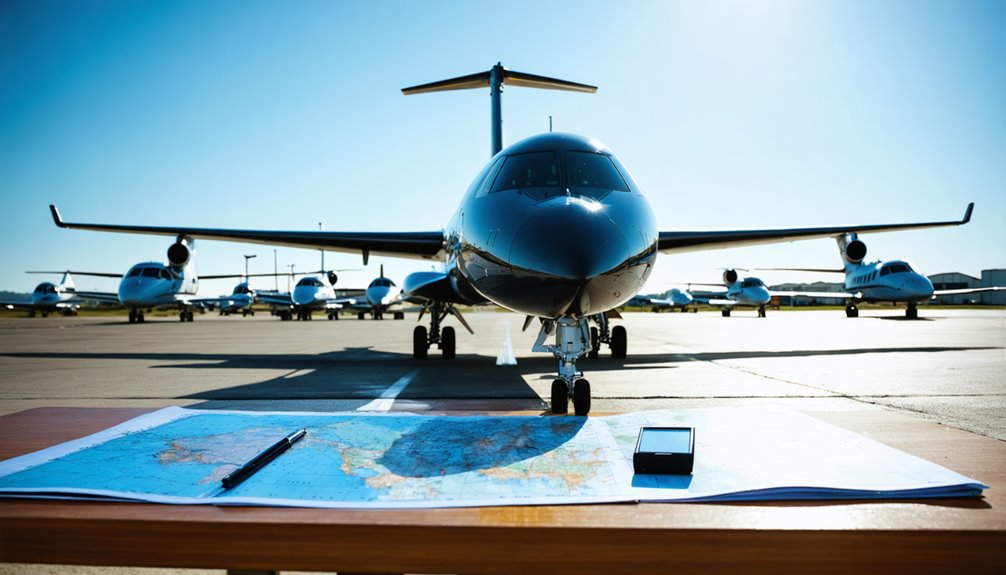
When looking into heavy jets, payload capacity is a key factor. You need to think about how much weight you have in passengers versus luggage. Most heavy jets can carry between 2,000 and 3,000 pounds. This means your team and their gear can travel together without issues.
Next, consider how payload impacts the jet’s range. If you’re booking private flights, remember that carrying a heavier load can limit how far the jet can fly.
Choosing the right aircraft is also important. For larger groups, the Gulfstream G650 can carry up to 4,000 pounds, making it a great choice.
If you’re traveling with a smaller executive team and moderate luggage, the Bombardier Global 7500, which has a 2,500-pound capacity, might be a better fit.
For those who want a mix of comfort and capacity, the Dassault Falcon 7X stands out. It offers a good balance between payload and a luxurious cabin experience.
Reviewing Safety Records and Certifications
Before you sign any rental agreement for a heavy jet, safety records and certifications should be your main focus. Checking an operator’s adherence to FAA regulations shows their dedication to safety.
Safety first, certifications matter—thorough vetting of jet operators reveals their true commitment to passenger well-being.
When I choose a heavy jet, I always ask for proof of Part 135 certification. This certification guarantees that the operator follows strict safety guidelines.
Third-party evaluations from organizations like Wyvern or ARGUS can give you important insights into how operators handle safety. It’s wise to look at recent maintenance logs to make sure the aircraft has passed detailed inspections.
You should also confirm that the crew members have the right type ratings for the heavy jet model you’re interested in and that they’re trained in emergency procedures. Although these checks may seem like a hassle, they’re crucial for ensuring a safe trip.
Analyzing Amenity Options for Long Flights
When you’re in the air for hours, the features of your heavy jet rental really matter. Comfort and productivity go hand in hand.
Look for jets that have designated areas for work and relaxation. This setup changes how you travel, making it more than just a ride.
Many heavy jets come packed with outstanding in-flight options. Full galleys allow for tasty meals, while fold-out meeting tables make it easy to conduct business.
Reliable power systems keep your devices charged. If you want the best for long flights, consider jets that offer both front and back lavatories. Some even include showers for that extra touch of luxury.
Luggage space is another key factor. High-end heavy jets can carry large items like golf clubs and skis without cramping the cabin.
This means you can be ready for any adventure when you land.
Exploring Airport Compatibility and Runway Requirements
When considering heavy jet rentals, airport infrastructure is key. Not all airfields can handle these powerful aircraft. For heavy jets, I recommend a runway length of at least 5,000 feet. This requirement can grow at higher altitudes due to lower engine efficiency.
It’s essential to check if your destination can bear the weight of heavy jets. The runway surface must be suitable. Many people forget about noise regulations, which can disrupt travel plans even if the aircraft is perfect.
For international flights, I confirm that your selected airports provide customs and immigration services. This step helps you avoid the stress of picking a jet that can’t land where you want to go.
Selecting the Right Charter Provider
When choosing a charter provider for heavy jet rentals, safety should be your top focus. Look closely at each company’s safety records. Check their certifications from trusted aviation authorities like ARGUS and Wyvern. These certifications show how serious they’re about keeping passengers safe.
Next, think about the quality of service. Read client testimonials to get a sense of their reputation. You can also ask the company directly about how they handle customer service. Pay attention to their responsiveness, how well they manage details, and if they can meet special requests.
Heavy jets come with various features that enhance comfort and efficiency. They typically have spacious cabins, large luggage capacity, and advanced navigation systems. This makes them ideal for long-distance travel.
Understanding these aspects can help you make a well-informed choice.
Safety Records Matter
When you want to rent a heavy jet, choosing a charter provider with a strong safety record is essential. Look closely at the company’s accident history and compliance with FAA regulations. This will show you how serious they’re about keeping passengers safe. It’s a good idea to ask for maintenance logs and safety certifications before you make your choice.
Always check if the company is a member of respected organizations like the Air Charter Association of North America (ACANA). These groups set high safety standards that go beyond the basics.
When I consider different options, I also pay attention to the qualifications and training of the pilots. You want to be sure the crew flying your plane meets top industry standards.
Reading passenger reviews can also be helpful. Look for comments that talk about safety experiences. These personal stories can give you a clearer picture of how a provider values safety and runs their operations.
Compare Service Standards
When choosing a heavy jet for your travels, safety records are important. They lay the groundwork for making a choice.
However, the level of service provided by charter companies can greatly influence your flying experience. In private aviation, outstanding service involves paying close attention to the details that make your trip enjoyable. Look into customer reviews from various platforms to understand the actual service levels.
When assessing charter companies, consider these points:
- Reliability in service across different flights and client feedback.
- Willingness to accommodate special requests and tailor the flying experience.
- Quality of onboard features, such as food options, internet access, and comfort in the cabin.
Heavy jets, like the Gulfstream G650 and Bombardier Global 7500, offer spacious interiors and advanced technology.
These jets are designed for long-distance travel, making comfort and efficiency key factors. Remember, high-quality service can transform your journey into a memorable adventure.
Balancing Luxury Features With Practical Necessities
When you want to rent a heavy jet, it’s important to find the right mix of luxury and practicality. Start by thinking about what you really need for your trip. Heavy jets, such as the Gulfstream GIV-SP, are known for their long ranges—over 4,500 nautical miles—which makes them ideal for global travel. However, remember that these jets can be costly to operate.
| Feature | Luxury Value | Practical Necessity |
|---|---|---|
| Ka-band Wi-Fi | High | Essential for business |
| Separate work areas | Medium | Critical for productivity |
| Full galley | High | Necessary for long flights |
The best heavy jet rentals offer a blend of comfort and functionality. Think about which luxurious features will help you meet your goals. If you’re traveling for business, look for amenities that boost your productivity. If your journey is for leisure, focus on comfort.
In the world of private aviation, heavy jets provide ample space and advanced technology. They can accommodate meetings or allow you to relax during long flights. Balancing luxury with practical needs can make your travel experience both enjoyable and efficient.
Planning for Special Requirements and Customizations
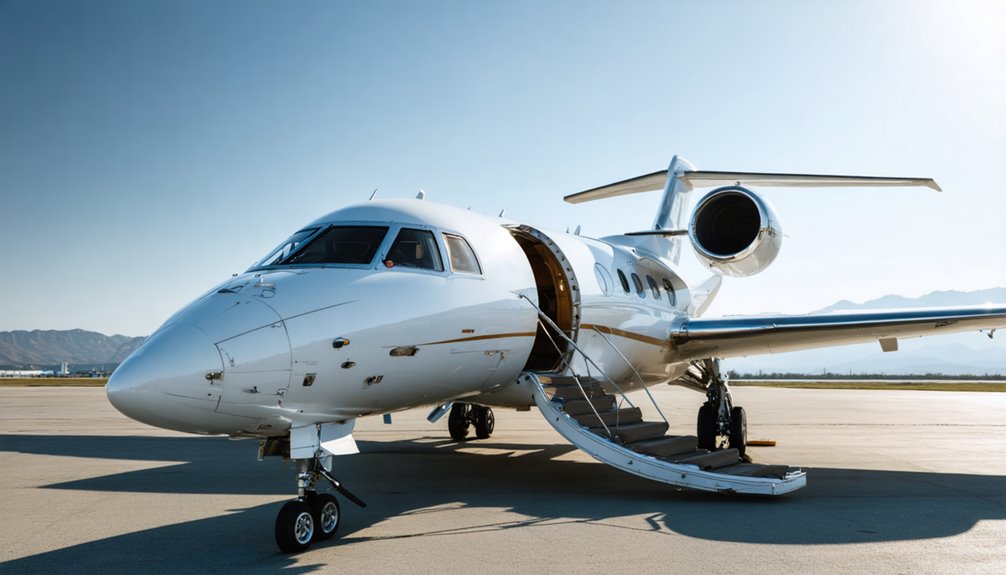
When you choose to rent a heavy jet, assessing your luggage needs is crucial. These aircraft have impressive space for large items, like sports gear or several suitcases for long journeys.
If you have specific health requirements, it’s wise to ask about in-flight medical features. Heavy jets can be equipped with tools like Automated External Defibrillators (AEDs) and emergency medical kits. Some can even be arranged to carry stretchers for passengers who need extra care.
It’s important to communicate your needs ahead of time with the charter company. This way, they can prepare everything you require.
Whether it’s about storing your items or addressing health concerns, heavy jets are versatile and can be tailored to fit your situation.
Luggage Capacity Options
Choosing a heavy jet with the right luggage capacity is important for your specific needs. When I help clients select an aircraft, I focus on matching their baggage requirements to the suitable heavy jet.
Heavy jets can generally carry up to 2,000 pounds of luggage. This makes them perfect for transporting items like golf clubs, ski gear, and large suitcases that can’t be taken on commercial flights.
One notable option is the Gulfstream GIV-SP. Its well-designed cabin layout ensures that passengers enjoy comfort while also making it easy to handle baggage.
Charter companies offer various customization options. You can detail your luggage needs before you book the flight to ensure everything fits.
It’s wise to discuss your unique baggage needs ahead of time. This way, your charter provider can prepare the aircraft’s storage space according to your journey’s demands.
In-flight Medical Amenities
When chartering a heavy jet, in-flight medical amenities are crucial. They act as your safety net at cruising altitude. Many clients overlook this aspect initially but often recognize its importance when unexpected situations arise.
Modern heavy jets are equipped with advanced medical kits and defibrillators. These tools ensure that you’re ready for emergencies. The real-time communication systems are particularly noteworthy. They connect you with ground-based medical professionals for immediate advice.
For travelers with specific health concerns, it’s wise to choose operators that provide customized services, including onboard medical staff. Heavy jets have spacious cabins that can be adapted for specialized medical equipment.
Some even offer medical evacuation services for quick transport to hospitals when needed. This feature is incredibly valuable in urgent situations.
Frequently Asked Questions
Can I Request Specific Flight Crews for My Heavy Jet Rental?
Yes, you can request specific flight crews for your heavy jet rental. We understand how important it is to have the right team on board. You can choose pilots based on their skills and experience. However, keep in mind that their availability will depend on scheduling.
I will connect you with qualified pilots who meet your needs. Heavy jets, known for their spacious interiors and long-range capabilities, often come with experienced crews. This ensures a smooth and safe flight experience. If you have particular preferences, just let us know, and we’ll do our best to accommodate them.
How Far in Advance Should I Book a Heavy Jet?
Booking a heavy jet requires careful planning. It’s wise to secure your reservation at least 2-3 months in advance. This timing helps you avoid the stress of last-minute arrangements. Heavy jets, known for their spacious interiors and long-range capabilities, are in high demand, especially during peak travel seasons.
Peak seasons can vary, but holidays and summer months often see an increase in private jet bookings. To ensure you get the aircraft you want, it’s best to book early. Checking the cancellation policies of your chosen service is also important. This gives you the flexibility to adjust your travel plans if necessary. Being prepared makes for a smoother travel experience.
Are Pet Accommodations Available on Heavy Jets?
Heavy jets welcome your pets! These spacious aircraft often have room for your furry friends. However, each operator has its own pet policies, so it’s important to check the specific rules.
Travel fees may apply based on your pet’s size and needs. It’s wise to prepare for these costs in advance. Heavy jets, like the Gulfstream G650 or Bombardier Global 7500, offer luxurious cabins that can accommodate both you and your animal comfortably.
When planning your trip, consider your pet’s comfort. Bring their favorite blanket or toys to make them feel at home. With the right preparations, you and your pet can enjoy a smooth journey together.
What Emergency Medical Equipment Is Standard on Heavy Jets?
Heavy jets are equipped with essential emergency medical equipment. A striking 94% of these aircraft include automated external defibrillators (AEDs). Besides defibrillators, heavy jets also carry standard first-aid kits. These supplies follow strict safety regulations and emergency protocols designed for in-flight medical situations.
Having AEDs on board is crucial. They can provide life-saving assistance during cardiac emergencies. First-aid kits contain various items such as bandages, antiseptics, and other medical supplies. These kits help crew members respond effectively to minor injuries or health issues that may arise during a flight.
Airlines prioritize passenger safety. They ensure that their heavy jets are ready for unexpected medical events. This preparedness can make a significant difference in outcomes during emergencies at 30,000 feet.
How Does Weather Affect Heavy Jet Performance and Scheduling?
Severe weather can greatly impact the performance of heavy jets and their schedules. For example, crosswinds can limit the runways that pilots can use. This can cause delays and require more careful planning during takeoff and landing. Icing can also be a serious issue. It affects lift, making it harder for the aircraft to climb and maintain altitude.
Flexibility is crucial when flying on a heavy jet. Weather conditions can change quickly, and it is essential to be ready for adjustments in travel plans. Heavy jets, like the Bombardier Global 7500 or the Gulfstream G650, are designed for long-range travel, but they are still affected by Mother Nature.
Conclusion
Choosing the right heavy jet for rental goes beyond luxury. It involves matching the aircraft’s capabilities with your unique requirements. Think of it like crafting a custom suit. You want it to fit perfectly.
First, consider passenger capacity. How many people will be traveling with you? Heavy jets typically seat between 8 to 16 passengers. Knowing your numbers helps narrow down your options.
Next, look at the range. Heavy jets can fly long distances—often over 6,000 miles. If you need to travel across continents without stops, this is crucial. Research the specific range of the models you’re interested in.
Comfort also plays a significant role. Heavy jets come equipped with spacious cabins, plush seating, and advanced amenities. Look for features that enhance relaxation and productivity, like Wi-Fi and entertainment systems.
Lastly, don’t forget about your budget. Heavy jets can vary widely in rental costs, depending on the model and included services. Researching industry standards can help you find options that fit your financial plan.
By focusing on these key factors—passenger capacity, range, comfort, and budget—you can find a heavy jet that meets your needs. Your journey will be more than a flight; it will be a personalized experience.
